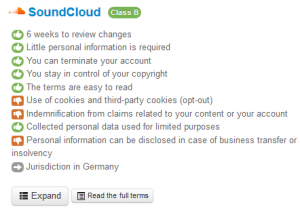Terms of service: the language that nobody reads
Source: techcrunch.com
While not specifically about learning languages, I still thought that this language-related tidbit was worth posting. A recent article on tech blog Techcrunch, somewhat dramatically titled “Putting an end to the biggest lie on the internet”, discusses something that we all both find familiar and yet instantly gloss over – terms of service.
When signing up to any web site (or installing most applications on your computer), it’s perfectly normal to be greeted by a wall of text, often in hard to navigate legalese or otherwise official sounding language, delineating the terms and conditions of using that site or application. Most people do not have an hour and a half to dedicate to reading and understanding each word of the T&C, and so just blithely click “I agree” in order to use the service.
However, companies know this just as well as users do, and some will occasionally hide rather less than savory conditions in there – for example, popular image host Twitpic.com takes credit for your content, and reserves the right to sell your images on to news agencies without giving any credit or money to the photographer.
 However, there is a new service that aims to help people wade through the terms and conditions and receive a bullet-point list of what exactly clicking “I agree” entails: the aptly-named TOS;DR (a play on the popular internet abbreviation TL;DR – “too long; didn’t read”).
However, there is a new service that aims to help people wade through the terms and conditions and receive a bullet-point list of what exactly clicking “I agree” entails: the aptly-named TOS;DR (a play on the popular internet abbreviation TL;DR – “too long; didn’t read”).
TOS;DR summarizes terms and conditions for you, and then rates sites, services and apps on a scale from A (the best) to E (the worst). Twitpic is, unsurprisingly, rated an E.
So, next time you’re faced with a list of terms and conditions as long as your arm just to use a particular site, check out TOS;DR and see what you’re really signing away when you click that “I agree” button.
